
WKCD has a deep commitment to school reform, especially high school. We join those who seek to promote, in some of the nation's most urban and rural areas, an unprecedented number of public schools, which in collaboration with their immediate community:
- arrange their resources so that each child is known well and then use this knowledge to shape each child's schooling
- set uncompromisingly high academic expectations for all children
- respectfully assess the progress of each student by means of a careful and continuing review of that child's actual work and then use that assessment to improve the child's learning
- exhibit daily the ideals of acting as a democratic and thoughtful learning community.
We believe that students should be seen and welcomed as crucial investors in school improvement.
PROJECTS
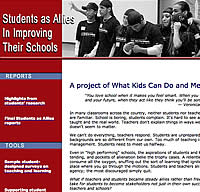 |
Students as Allies in School Reform What if teachers and students became steady allies rather than frequent adversaries in their daily classroom encounters? What would it take for students to become stakeholders not just in their own success but also in that of their teachers and schools? In 2003-2004, with support from MetLife Foundation, WKCD explored these questions with student research teams and educators in Chicago, Houston, Oakland, Philadelphia, and St. Louis. Students surveyed classmates and teachers, presented their findings at public forums, and shaped recommendations for change. We've updated the survey and supporting materials for 2011 and invite, again, teachers and students in schoools nationwide to take up our call to make students allies in school reform. |
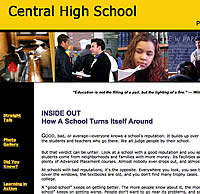 |
Inside Out: How a School Turns Itself Around |
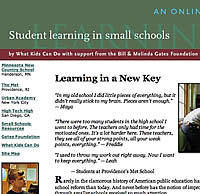 |
Student Learning in Small Schools: An Online Portfolio In 2003 WKCD, with support from the Bill & Melinda Gates Foundation, compiled a comprehensive digital portfolio to capture teaching and student learning in four small schools: Minnesota New Country School (Henderson, MN), The Met School (Providence, RI), Urban Academy (New York City), and High Tech High (San Diego, CA). The portfolio is filled with teacher assignments and student work, along with an array of documents and protocols that give these schools their structure and energy. |
BOOKS & SMALL PUBLICATIONS
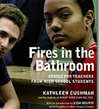 |
Fires in the Bathroom: Advice for Teachers from High School Students (The New Press, 2003) by Kathleen Cushman and the students of What Kids Can Do, Inc. In ten practical chapters from “Creating a Culture of Success” to “When Things Go Wrong,” students from across the country give their unvarnished advice on how they can be engaged, motivated, and challenged. Starting with how to build mutual understanding and respect, they tackle crucial issues of classroom behavior, group work, language difficulties, and homework, offering insight on ways to improve classroom life and relationships between teachers and students. “Turns the tables on adults.” – The New York Times; “A torrent of sensible, honest observations…If ever there we an authentic plea to make our schools human, this is it.” – Theodore Sizer |
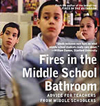 |
Fires in the Middle School Bathroom: Advice for Teachers from Middle Schoolers (The New Press, 2008) by Kathleen Cushman and Laura Rogers and the students of What Kids Can Do, Inc. What do middle schoolers wish teachers knew about them and how they best learn? This sequel to Fires in the Bathroom: Advice for Teachers form High School Students provides a much-needed window into the world of early alliance. Diverse student voices offer teachers insight into how their best practices actually play out as students change and develop, day by day, in the middle grades classroom. “We’re starting to turn into adults, so we’re not really sure what’s expects of us.” – Geoffrey; “The science teacher kept me after school. I thought it was for a bad reason, but he just wanted to get me more involved.” - Kenson |
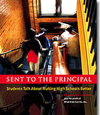 |
Sent to the Principal: Students Talk About Making High School Better (Next Generation Press, August 2005) by Kathleen Cushman and the students of What Kids Can Do We often think of adults as investing their time, ideas, and money in making schools better. If we took students equally seriously as investors, we might realize greater rewards: increased motivation, better communication, a more welcoming environment, and improved learning outcomes. How can school leaders make students allies in improving their schools? In this book, students offer some compelling answers. |
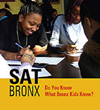 |
SAT BRONX: DO You Know What Bronx Kids Know? (Next Generation Press, May 2008) by students from Bronx Leadership Academy 2, BLA2 teachers Shannon O’Grady and Kristin Ferrales, and Kathleen Cushman What do inner-city teenagers know that the rest of us may not? What can they do that others might find daunting? What can we all learn, from thinking through the issues that confront urban youth? SAT Bronx aims to find out, by framing the words and experiences of fourteen Bronx high school students in the form of standardized test passages. To answer its multiple-choice questions (co-constructed with two of the students’ teachers and with Kathleen Cushman of What Kids Can Do), one must analyze complex matters of culture, language, behavior, even governmental policy. Taking SAT Bronx opens important conversations about multiculturalism equity, and the assumptions that underlie our thinking about urban youth. |
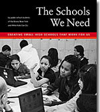 |
The Schools We Need: Creating Small High Schools That Work For Us (PDF) (May 2003) What’s so different about a small high school, compared to a large one? When school leaders decide to create more small schools in their district, how do students experience the change in their everyday routines, as well as in their sense of power and possibility? In this publication—a joint effort of WKCD, the Bronx New Century High Schools, and the Carnegie Corporation—two dozen students in Bronx, NY talk about their experiences planning and attending small schools and breaking down large high schools. |
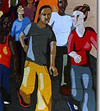 |
Taking Democracy In Hand: Youth Action For Educational Change in the San Francisco Bay Area (PDF) (May 2002) More than field notes but less than a case study, this informal paper draws upon site interviews and conversations with ten Bay Area youth organizing groups, highlighting some of their burgeoning accomplishments and growing wisdom. It also sketches how their work builds, step by step, capital and capacity among participants; why youth-adult partnerships are important; where dots are being connected (between issues, between strategies, across races) and where they need connection (between youth and adult school reformers). |
First Ask, Then Listen: How to Get Your Students to Help You Teach Them Better (PDF) (September 2003)
This short manual describes the process and questions behind WKCD's book Fires in the Bathroom. It offers prompts and exercises for teachers wanting to start a dialogue with their own students.
MEDIA
School As Subject: Four Student Documentaries about School Equality, Redesign, and College Access
“Education is not the filling of a pail, but the lighting of a fire.” – William Butler Yeats
For the past several years, WKCD has supported student video projects as part of our Student Research for Action program. Two beliefs under gird this support. First, that young people have the capacity to reflect critically on the institutions and communities that touch their lives. And second, that video offers students an exceptional tool for asking their own questions, making their own observations, telling their own stories—and sharing them publicly.
In the four films shown here, students turn their lens on a subject close at hand: school. Students at Brighton High School document stark inequalities between urban and suburban schools in Boston. In Enumclaw, Washington and Bronx, New York, students share the struggles that come with breaking large high schools into smaller schools. At another Bronx high school, Bronx International, immigrant students examine the obstacles in their path to college.
A grant from the Bill & Melinda Gates Foundation made these films possible.
FEATURE STORIES
Youth and Adults Transforming School Together (February 2011)
On a crisp fall weekend, 165 youth and adults from high schools throughout Vermont pack a large, renovated barn on the campus of Goddard College. They have gathered to “Be the Buzz”: to speak up, dig deep, and work together for school transformation in their schools and across the state .“This is what real youth–adult partnership looks like,” one teacher remarks. A student adds, “And what school change sounds like.”
Education Blogs, Newsletters, and More: Some WKCD Favorites (January 2011)
We are often asked where turn most often for online information, news, analysis, a ground eye’s view of the classroom—and inspiration. Here’s our current list of blogs, networks, idea generators, and newsletters that grab our attention. In these days of overstuffed inboxes, the temptation to treat so much electronic mail as spam—or pass up another tip for a good website— is understandable. These, we believe, are worth a look, depending on your interest and role.
Chicago Teens Say Better Tech Use Would Improve Learning (November 2010)
In March 2009, WKCD wrote about the involvement of students from Chicago’s Mikva Challenge in citywide policy discussions about improving school safety. The youth sent a clear message: they want to be part of bringing positive change to Chicago Public Schools (CPS). This October, Mikva Challenge youth issued a new report that’s turning heads—on how CPS needs to overhaul its technology policy to catch up with the 21st Century.
Best Practices in Summer Learning Programs: A Y-Press Report (November 2010)
“Summer learning loss” has gained prominence as another hurdle to improving student achievement. WKCD recently asked our partners at the youth-led news bureau Y-Press to investigate best practices in summer learning programs, interviewing experts in the field and students returning to school with summer learning experiences in their backpack. Their piece complements Y-Press alumna Jordan Denari’s “A Camp that Gets the Story.”
Fighting Summer Learning Loss: One City's Story (September 2010)
One hears a lot these days about "summer learning loss" and its toll on low-income students. This summer WKCD asked Jordan Denari, whom we met three years ago when she was a junior in high school and editor at the Indianapolis youth-led Y-Press, to document her experience leading "City Stories"—a remarkable two-week summer camp in which Y-Press teenagers teach younger students 21st century journalism skills. Denari, now a sophomore at Georgetown University, recorded every aspect of the camp's unfolding, producing a powerful feature story and two videos.
Having a Say: Youth and Educational Activism (July 2009)
Ever since school was made compulsory for American children in the early 20th century, efforts at reform rarely included input from youth. But that is changing, as policymakers are beginning to value the opinions of youth, and as youth themselves have realized their collective power through new networking media. Ten years ago, it was hard for young people, or adults even, to know whom to lobby, to find which elected officials, let alone to figure out how to contact them.
Our Schools, Our Future: San Francisco Youth Campaign for Equitable College Access (August 2009)
It’s lunchtime at Balboa High School, once one of San Francisco’s most troubled schools but now on the rebound. Twenty-five students grab a sandwich and a seat. In six hours, the San Francisco Board of Education will vote on a policy these students have fought for all year long: to make the “A through G” course curriculum, required for admission to California’s state universities and colleges, the default curriculum for all students in the San Francisco Unified School District.
Having a Say: Youth and Educational Activism (August 2009)
Ever since school was made compulsory for American children in the early 20th century, efforts at reform rarely included input from youth. But that is changing, as policymakers are beginning to value the opinions of youth, and as youth themselves have realized their collective power through new networking media. Ten years ago, it was hard for young people, or adults even, to know whom to lobby, to find which elected officials, let alone to figure out how to contact them.
History You Can Touch (June 2009)
“I’ll be talking about courage and Common Sense with Thomas Paine,” begins Carriola Chambers, 16, as she steels her nerves. It’s presentation day at Facing History School (FHS) in mid-Manhattan and students like Carriola are demonstrating to small panels of teachers and peers how they have advanced their “habits of learning” over the quarter. There’s a passion for self-discovery through history at FHS that you won’t find at any other school.
The Big Score: Chicago High School Students Debate College Admission Tests (March 2008)
For students at Chicago’s Oak Park and River Forest High School (OPRF), the buzz surrounding college preparation is intense. The school sends almost 90 percent of its graduates to college. In January 2008, WKCD sat down with five OPRF students to talk about how they judge intelligence, and their experiences with standardized tests.
Youth United for Change and Philadelphia’s public schools (May 2007)
On a recent afternoon, 35 students from the small schools housed in Kensington High School in north Philadelphia gather around a table in their meager school library. Most came because they saw a flier advertising free pizza at a meeting of an organization called Youth United for Change. But it soon becomes clear that this meeting is about much more than an after-school snack—it’s about tackling inequality in their city’s public schools.
Michigan special needs students find their stride (June 2007)
Between finding your way to your locker, passing your classes, and avoiding those intimidating upperclassmen, freshman year of high school is tough for almost everyone. Add special needs or disabilities to that equation and the difficulties can grow exponentially. But for special needs students at Haslett High School, a program called Freshman Focus is giving them a leg up.
Hear Us Out: Advice from Students for School Leaders
(November 2005)
If you are a high school principal, your students want to have a word with you. Last year, WKCD spent six months collecting perspectives on school leadership from 65 high school students nationwide. In a new book, Sent to the Principal: Students Talk About Making High Schools Better, teenagers shares their insights on a range of issues.
Restoring Hope Where It's All but Gone
(September 2005)
Students enrolled in Indianapolis public high schools face hard truths everyday. Indianapolis has the fifth worst graduation rate in the country; only 25 percent of black males earn a high school diploma. Student research teams at all five of the city's high schools have studied the problems and are adding their voice to the district's redesign effort.
We Are Change (September 2006)
With a video camera to her eye, Alice Giaccone, 18, moves through a buzzing high school hallway at lunchtime. She poses the same question to each person she stops: “What do you think of high school redesign?” Alice, along with seven other “youth mobilizers,” spent the past year documenting what young people want—and don’t want—from their high schools in Austin, TX.
Reflections on What Works: A Group of Teenage Classroom Observers Raises the Bar for Teachers
(February 2006)
At Lexington High School, a large suburban high school outside Boston, a dedicated crew of teenaged students is visiting classrooms with an innovative vision of student-teacher dialogue. They go into classrooms not to learn what is being taught, but to look at how it is being taught, and to create a dialogue about effective teaching and learning.
Tough Talk about Student Responsibility: Growing Student Leaders in Oakland, CA (October 2004)
Several years ago at Oakland Tech High School Darrick Smith began a program called TryUMF (for Try and Uplift My Folks), a leadership class any student can take and re-take. Smith makes fierce academic and social demands on students, but they pay off. Recently WKCD interviewed Smith and his students about their push for responsibility.
Young Filmmakers Turn Their Cameras on Their Schools (August 2004)
What makes a teacher worth paying attention to? What makes a school worth going to? Listen Up!, a network of 60 youth media organizations nationwide, invited ten youth production teams to answer these questions. See clips from their films.
The Color of Learning: Youth Researchers Tackle the Legacy of Brown
(May 2004)
For three years, one hundred inner city and suburban youth researchers and their adult partners at the Graduate Center of the City University of New York have studied how race influences learning in schools across America. Here we present some of the fruits of their extraordinary work.
The Color of Teaching: In a Small Black School, Students Fight for Their Faculty (May 2004)
Nationally, urban schools struggle to recruit minority teachers. In the rural, African-American community of Camp Hill, Alabama, students struggle with a county decision to replace a third of their school’s black teachers with white teachers.
From: High School Students To: The Next President (March 2004)
Dear Future President: I am nineteen years old and I have lived in Harlem all my life. This past year, I got my G.E.D., and I’m about to start college at Cooper Union in New York City. I work several jobs to raise the money I’ll need to live on. I can talk like an educated person, and I can talk like the kids on the street. You would probably point to me as a success story. But you wouldn’t have much idea of what got me here. Maybe you should....Read letters by two WKCD student authors on what we can do about the real crisis in public education—part of a new book published by Teachers College Press.
Redesigning High Schools: Student Perspectives (October 2003)
When the Bill & Melinda Gates Foundation and The Education Alliance at Brown University hosted a "Practitioners Forum for High School Redesign," a dozen students from high schools throughout the Northeast were among the 120 in attendance. Read students' comments about redesigning high schools, student-teacher relationships, and what makes quality schools.
Youth Organizers Mobilize to Change their World, Starting with School (June 2003)
This special collection features two experienced youth organizing groups—East Los Angeles’ Youth Organizing Communities and the Bronx's Sistas and Brothas United—working to improve their schools, an interview with a veteran youth activist, and an annotated directory of student groups involved in school reform.)
Students Push for Equity in School Funding (June 2003)
Nationwide, schools face drastic reductions in programs, teachers, and services. Here we capture the triumphs, defeats, and voices of Alabama students fighting to save their small school from consolidation, Ohio students rallying at their state’s capitol against funding inequities, and a government class in Poughkeepsie, NY throwing itself into that district’s school budget deliberations.



